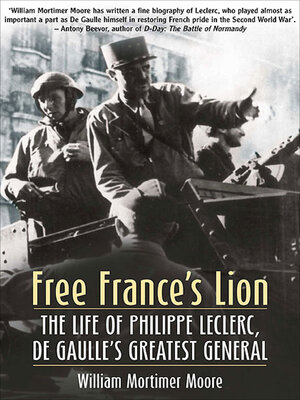Free France's Lion
ebook ∣ The Life of Philippe Leclerc, de Gaulle's Greatest General
By William Mortimer Moore

Sign up to save your library
With an OverDrive account, you can save your favorite libraries for at-a-glance information about availability. Find out more about OverDrive accounts.
Find this title in Libby, the library reading app by OverDrive.



Search for a digital library with this title
Title found at these libraries:
| Library Name | Distance |
|---|---|
| Loading... |
“A fine biography of Leclerc, who played almost as important a part as de Gaulle himself in restoring French pride in the Second World War” (Antony Beevor, international bestselling author of D-Day).
From the fall of France until 1943, Philippe Leclerc dovetailed his operations with the British effort in North Africa, establishing himself as a dynamic combat leader in the battles against Rommel. But once the conflict shifted to European soil, he became even more prominent as the commander of the 2nd French Armored Division—the famous 2e DB). For the next two years, he was under the operational control of either Patton’s Third Army, as in the Normandy breakout, Hodges’ First Army, at the Westwall, or Patch’s Seventh Army in the south.
His career not only includes the liberation of Paris, for which he is most famous, but the retaking of Strasbourg and the reduction of the Colmar Pocket. Helping to spearhead the advance into Germany itself, Leclerc’s armor comprised a rock upon which American units could rely, and its waving the tricolor during the Allied counter-invasion went far toward retrieving French prestige in the war. Leclerc is one of very few Frenchmen of whom it can be said that he never stopped fighting to regain France’s freedom, from the debacle of 1940 right through to the end.
The “first full-scale biography in English of the ‘liberator of Paris,’” Free France’s Lion will make fascinating reading for any serious student of the full scope of World War II (Publishers Weekly).
From the fall of France until 1943, Philippe Leclerc dovetailed his operations with the British effort in North Africa, establishing himself as a dynamic combat leader in the battles against Rommel. But once the conflict shifted to European soil, he became even more prominent as the commander of the 2nd French Armored Division—the famous 2e DB). For the next two years, he was under the operational control of either Patton’s Third Army, as in the Normandy breakout, Hodges’ First Army, at the Westwall, or Patch’s Seventh Army in the south.
His career not only includes the liberation of Paris, for which he is most famous, but the retaking of Strasbourg and the reduction of the Colmar Pocket. Helping to spearhead the advance into Germany itself, Leclerc’s armor comprised a rock upon which American units could rely, and its waving the tricolor during the Allied counter-invasion went far toward retrieving French prestige in the war. Leclerc is one of very few Frenchmen of whom it can be said that he never stopped fighting to regain France’s freedom, from the debacle of 1940 right through to the end.
The “first full-scale biography in English of the ‘liberator of Paris,’” Free France’s Lion will make fascinating reading for any serious student of the full scope of World War II (Publishers Weekly).







